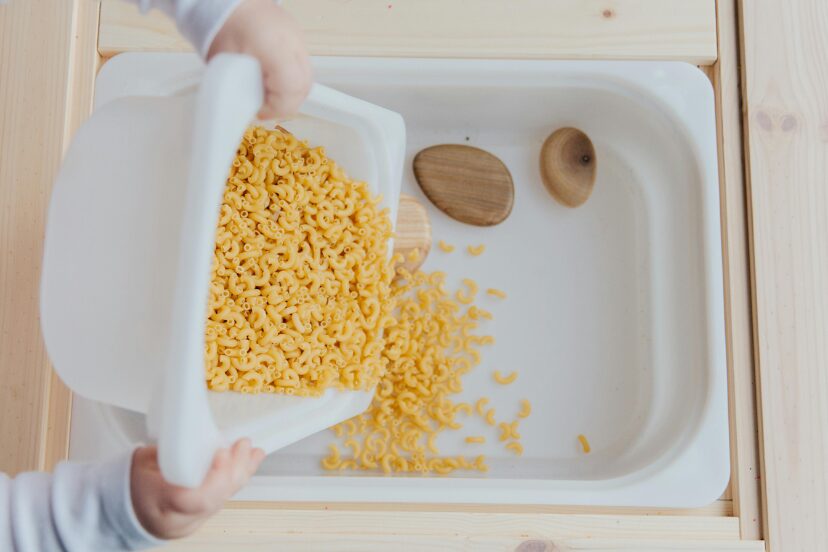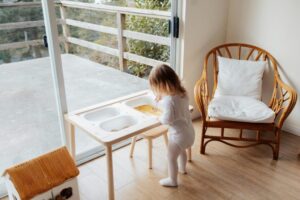Sensory bins are a popular tool used by parents, educators, and therapists to provide a hands-on, multi-sensory learning experience for children. These bins are filled with various materials that stimulate the senses, such as rice, beans, sand, water, or small toys. The goal of sensory bins is to engage a child’s curiosity and encourage them to explore and interact with the materials in a fun and educational way.
Our Top-rated Picks for Sensory Bins
- Sensory Bin Set: This is a classic sensory bin set that are reusable and can be filled with any fillers and customized with your own materials. This allows children to explore the properties of many different types of sensory mediums. The bins come with lids for easy storage and can be used both indoors and outdoors.
- Dinosaur Sensory Bin: This themed sensory bin is perfect for dinosaur lovers. It includes a variety of dinosaur figurines, rocks, and sand to create a prehistoric playground.
- Ocean Sensory Bin: This under-the-sea themed bin is filled with blue sand, sand castle molds, and ocean animal figurines. Children can explore the ocean environment while learning about sea creatures.
- Farm Sensory Bin: This bin is filled with farm animal figurines, hay, and sensory sand. Children can pretend to be farmers and care for their animals while exploring the textures and smells of the farm.
What are Sensory Bins?
Sensory bins are containers filled with various materials that stimulate a child’s senses. They are designed to be interactive and engaging, allowing children to explore, manipulate, and learn through hands-on play.
Why We Love Them
Sensory bins are a fantastic way to encourage exploration, creativity, and problem-solving skills in children. They provide a multi-sensory learning experience that can be tailored to a child’s interests and developmental needs. Additionally, sensory bins can be used to teach a variety of concepts, such as colors, shapes, textures, and counting.
Sensory Benefits
Sensory bins offer numerous benefits for children, including:
- Sensory Integration: Sensory bins help children integrate and process sensory information, which can improve their overall sensory processing abilities.
- Fine Motor Skills: Manipulating materials in a sensory bin helps develop fine motor skills, such as grasping, pinching, and pouring.
- Language Development: A sensory bin can be used to introduce new vocabulary and encourage children to describe their experiences using descriptive language.
- Cognitive Development: Sensory bins promote problem-solving, critical thinking, and creativity, which can enhance a child’s cognitive development.
Which Kind of Sensory Seekers Would Like Them?
Sensory bins are suitable for children of all ages and sensory needs. They are particularly beneficial for children who are sensory seekers, as they provide a safe and engaging environment for them to explore and interact with different textures, smells, and sounds.
Types of Sensory Bins
There are countless themes and materials that can be used to create sensory bins, making them versatile and customizable to a child’s interests. Some popular types of sensory bins include:
- Textured: These bins are filled with materials that have unique textures, such as shaving cream, slime, or playdough.
- Themed: These bins are designed around a specific theme, such as a farm, ocean, or dinosaur world.
- Seasonal: These bins are created to celebrate different seasons or holidays, such as a winter wonderland or a Halloween-themed bin.
- Food-Themed: These bins are filled with edible materials, such as cooked spaghetti, jello, or cereal, and can be a fun and safe way for children to explore different food textures.
Similar Things People Might Like:
If you enjoy sensory bins, you may also enjoy other sensory activities, such as:
- Playdough/Clay: Fantastic for fine motor skills, creativity, and tactile input.
- Slime: Offers unique textures, stretching, and squishing.
- Sensory Tables/Sandboxes: Larger-scale versions of sensory bins, perfect for outdoor play.
- Finger Painting/Messy Art: Embracing the delightful mess of creation.
- Mud Kitchens: An outdoor extension where kids can mix “ingredients” from nature to create imaginary meals.
- Loose Parts Play: Providing a collection of various materials (buttons, beads, blocks, natural items) for open-ended construction and imaginative play.
In conclusion, sensory bins are a fantastic tool for promoting learning, exploration, and sensory integration in children. With countless themes and materials to choose from, there is a sensory bin for every child’s interests and needs. So, grab a bin, fill it with your favorite materials, and let the sensory fun begin!


